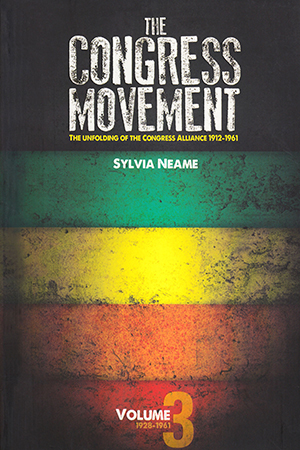
- 2015/538 pages
- Distributed for HSRC Press
The Congress Movement, Volume 3:
The Unfolding of the Congress Alliance 1912-1961
Sylvia Neame
Paperback: $35.00
ISBN: 978-0-7969-2488-9
The Congress Movement, based on primary and secondary sources including some 80 interviews dating back to the early 1960s, uniquely combines narrative and analysis.
Volume 3 explores how the ANC emerges and stps into its primary role as a national liberation movement resulting from a complex process stretching from the 1920s to the beginning of the 1960s. A key theme in this context is the integral role of the then Congress Youth League leaders such as Nelson Mandela, Walter Sisulu, and Oliver Tambo.
Volume 3 explores how the ANC emerges and stps into its primary role as a national liberation movement resulting from a complex process stretching from the 1920s to the beginning of the 1960s. A key theme in this context is the integral role of the then Congress Youth League leaders such as Nelson Mandela, Walter Sisulu, and Oliver Tambo.
Sylvia Neame is a long-standing member of the African National Congress movement and the South African Communist Party. She is author of Imprisoned: The Experiences of a Prisoner of Apartheid and, most recently, The Drama of the Peace Process: I Look Back 30 Years.
- SEARCHING FOR THE ADEQUATE FORM OF THE UNITED FRONT, 1928–34: THREATS TO THE AFRICAN NATIONAL CONGRESS'S PRIMARY ROLE.
- Threats to the African National Congress's Primary Role.
- The ANC–ICU 1928 Decision to Cooperate: With an Anti-Communist Rider: Issue of Passes, 1928–30.
- What Kind of Organisation Was the LAR?
- Mahabane Takes the Lead in Calling for an African Convention.
- Mahabane's Policy of a Black–White Round Table and Declaration of Rights, 1929 ANC Conference.
- The Communists' Attitude to Mahabane's Policies.
- Mahabane and Communism, 1929.
- Maneuvers to Dismantle the ANC’s Primary Role, 1926–30.
- Gumede Loses the Congress Presidency.
- Plans to Restructure the ANC on the Basis of Employees' Organisations: Ballinger's Role.
- The Non-European Conference.
- AFRICAN NATIONAL CONGRESS AT THE TIME OF THE SEME PRESIDENCY, 1930–37: THE ORGANISATION'S CONGRESS CHARACTER IS ENDANGERED.
- The Organisation's Congress Character is Endangered.
- Seme's Political Positions at the Time of the Founding of the Congress.
- The New Seme Constitution.
- Seme and the Upper House at the Time of the Mahabane Presidency, 1937–40.
- Seme, Business.
- Fate of the Heaton Nicholls Initiative in the Framework of the Joint Select Committee.
- African National Congress Leaders and the Nicholls Plan.
- State of the African National Congress in the First Half of the 1930s.
- Liberals Prime DDT Jabavu as African Leader on the Franchise Proposals.
- Congress Leaders Call for an All-African Convention: The Regional Conferences.
- The All-African Convention, 1935.
- Maneuvers Around the "Compromise" of 1936.
- Thema, Dube, and Seme and the "Compromise."
- Seme's Removal at the 1937 Conference: Mahabane Puts the African National Congress Back on Course.
- THE ALL-AFRICAN CONVENTION AND THE AFRICAN NATIONAL CONGRESS, 1937–48: A FEDERAL OR UNITARY PRINCIPLE?
- A Federal or Unitary Principle?
- Kadalie's Response to the All-African Convention.
- Was the All-African Convention a New Social Movement?
- The Communists' Attitude to the All-African Convention.
- Reservations About the All-African Convention and Early Moves to Revive the African National Congress.
- The All-African Convention Challenge is Defeated.
- The ANC Adopts a New Constitution in 1943.
- Xuma and the All-African Convention: Non-European Unity Movement, Including the "Meeting of the 12 Leaders."
- THE AFRICAN NATIONAL CONGRESS UNDER ZUMA, 1940-49: TO WHAT EXTENT WAS IT A BREAK WITH A PREVIOUS ERA?
- To What Extent Was It a Break With the Previous Era?
- Were Congress Councillors on the Native Representative Council Mandated by the ANC?
- Division of Labor Between Z.K. Matthews and Xuma: The 1943 NRC Recess Committee on Representation.
- A New Phase Opens With Africans' Claims.
- The Pass Campaign, 1943–46.
- The Crisis Conditions of 1946.
- Xuma, Congress, and Trade Unionism.
- Xuma's Evidence to the Native Mine Wages Commission of 1943.
- Prelude to the African Mine Workers' Strike.
- The African Mine Workers' Strike, 1946.
- The Communists and the Question of a Non-European Trade Union Federation.
- What Was Xuma's Attitude Towards the Mine Strike?
- Adjournment of the Native Representative Council and the Smuts Proposals.
- Xuma, the ANC, and the Boycott of the NRC.
- Xuma and Organisation.
- Growing Political Role of Indian Leaders.
- The People's Assembly of 1948: Problems of the United Front.
- PHASE OF THE PROGRAMME OF ACTION, 1948-50: A COMPLICATED HISTORICAL JUNCTURE.
- A Complicated Historical Juncture.
- The ANC and the General Election of 1948.
- Emergence of the Youth League: What Was Its Strategy?
- The CYL's Programme for a New South Africa.
- The Issue of a Programme of Action Prior to the ANC's 1948 Conference.
- The ANC Annual Conference, December 1948, and a Programme of Action.
- Efforts to Draft a Programme of Action During 1949.
- Response of the Communists to the Programme.
- The Difficulties of Leading Youth Leaguers with the Defend Free Speech Convention, 1950.
- Suppression of Communism Act: Mandela, Tambo, Sisulu Jettison Anti-Communism.
- CHAMPION, MSIMANG, AND THEMA LEAVE THE AFRICAN NATIONAL CONGRESS, 1951–1952: END OF AN ERA.
- End of an Era.
- The CYL and Radical Democracy.
- The CYL and Trade Unionism: The CYL’s Attitude to the ICU.
- Kadalie's Last Years.
- Champion's Efforts to Secure the Role of "Leader of Natal."
- Champion's Growing Irritation with the ANC.
- Natal, the National Fund, the Afrikaner Nationalists, and the Zulu Royal House.
- African–Indian Confrontation in Durban: The 1949 Riots.
- Champion's Attitude to the Youth Leaguers and to the Programme of Action.
- Msimang Turns Against Champion and Lutuli Takes Over the Natal Leadership.
- The Baloyi Issue, Congress, and Afrikaner Nationalists.
- Selope Thema's Role in Congress, 1946–49.
- Thema in 1949.
- Establishment of the National-Minded Bloc.
- The National-Minded Bloc, Business, and "Economic Independence."
- The Youth Leaguers and the National-Minded Bloc.
- Common Basis of Thema, Champion, and Msimang Leave the ANC.
- Defiance Campaign, 1952. Xuma and the ANC, Late 1940s/Early 1950s, Including His Attitude to the Defiance Campaign.
- Postscript: How Did Xuma Come to Turn Against the ANC?
- LUTULI AND MANDELA, 1952–61: THE MAHABANE HERITAGE.
- The Mahabane Heritage.
- The Problem of a United Front with the Liberal Party.
- The ANC, the Liberal Party, and the COP.
- What Influences Shaped the Freedom Charter?
- The Land Shall Be Shared Among Those Who Work It.
- What Organisation or Organisational Framework Was Responsible for the Charter?
- Lutuli and the Freedom Charter.
- The M-Plan: Preparation for Revolution?
- The M-Plan and the South African Congress of Trade Unions.
- The 1958 ANC Constitution and the Question of Centralisation.
- Political Orientation of the IDAMF.
- All-in African Conference, October 1956.
- Multiracial Conference, December 1957: The Question of the Broad Front.
- Proceedings of the Multiracial Conference.
- Was the Multiracial Conference Simply a Dead End?
- Dialogue Continues.
- Liberal Party–ANC Relationship in the Late 1950s.
- The PAC.
- Why Did the ANC Leadership Prevaricate on the Issue of a Pass Campaign?
- Growing Lack of Confidence in the Method of Mass Campaigns.
- Crisis Symptoms in the Economy.
- "Sharpeville": Was it a Herald of Revolution or Counter-Revolution?
- Conceptual Considerations in Relation to the Call for a National Convention, 1960–61.
- Consultative Conference, December 1960, and All-in African Conference, March 1961.







